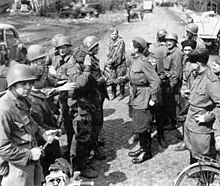User:Paul Siebert/SandboxCollapse
Axis collapse, Allied victory
[edit]
On January 12, 1945, the Soviets launched a massive offensive in Poland, taking much of Poland, including Warsaw, and striking deep within the borders of the Reich. Subsequent advance towards Berlin had been postponed for two months to repulse a German counter-attack on the northern flank and to neutralize strong German troops in Pomerania, Eastern Prussia and Silesia.[1]
On February 4, U.S., British, and Soviet leaders met in Yalta. They agreed on the occupation of post-war Germany,[2] and when the Soviet Union would join the war against Japan.[3]
In March, Western Allied forces entered Germany, crossing the Rhine river north and south of the Ruhr, encircling a large number of German troops, while the Soviets advanced to Vienna. In early April the Western Allies finally pushed forward in Italy and swept across western Germany, while in late April Soviet forces stormed Berlin; the two forces linked up on Elbe river on April 25.
Several changes in leadership occurred during this period. On April 12, U.S. President Roosevelt died; he was succeeded by Harry Truman. Mussolini was killed by Italian partisans on April 28[4] and two days later Hitler committed suicide, succeeded by Grand Admiral Karl Dönitz.[5]
German forces surrendered in Italy on April 29 and in Western Europe on May 7.[6] However, fighting continued on the Eastern Front until the Germans surrendered specifically to the Soviets on May 8. In Prague, resistance of remnants of German Army continued until May 11.
[[:Image:Soviet flag on the Reichstag roof Khaldei.jpg|right|thumb|Soviet soldiers raising the Soviet flag over the Reichstag after its capture]]
In the Pacific theater, American forces advanced in the Philippines, clearing Leyte by the end of 1944. They landed on Luzon in January 1945 and Mindanao in March.[7] British and Chinese forces defeated the Japanese in northern Burma from October to March, then the British pushed on to Rangoon by May 3.[8] American forces also moved toward Japan, taking Iwo Jima by March, and Okinawa by June.[9] American bombers destroyed Japanese cities, and American submarines cut off Japanese imports.[10]
On July 11, the Allied leaders met in Potsdam, Germany. They confirmed earlier agreements about Germany,[11] and reiterated the demand for unconditional surrender by Japan, specifically stating that "the alternative for Japan is prompt and utter destruction".[12] During this conference the United Kingdom held its general election and Clement Attlee replaced Churchill as Prime Minister.
When Japan continued to reject the Potsdam terms, the United States then dropped atomic bombs on the Japanese cities of Hiroshima and Nagasaki in early August. Between the two bombs, the Soviets invaded Japanese-held Manchuria, as agreed at Yalta. On August 15, 1945 Japan surrendered, ending the war.[6]
- ^ Glantz, David M. The Soviet-German War 1941-1945: Myths and Realities: A Survey Essay pg. 85
- ^ Solsten, Eric. Dwight Germany: A Country Study , pgs. 76-77
- ^ United States Dept. of State. The China White Paper, August 1949, pg. 113
- ^ O'Reilly, Charles T. Forgotten Battles: Italy's War of Liberation, 1943-1945, pg. 244
- ^ Kershaw, Ian. Hitler, 1936-1945: Nemesis, pg. 823
- ^ a b Donnelly, Mark. Britain in the Second World War, pg. xiv
- ^ Chant, Christopher. The Encyclopedia of Codenames of World War II, pg. 118
- ^ Drea, Edward J. In the Service of the Emperor: Essays on the Imperial Japanese Army, pg. 57
- ^ Jowett, Philip S. The Japanese Army, 1931-45, pg. 6
- ^ Poirier, Michel Thomas (1999-10-20). "Results of the German and American Submarine Campaigns of World War II". U.S. Navy. Retrieved 2008-04-13.
- ^ Williams, Andrew J. Liberalism and War: The Victors and the Vanquished, pg. 90
- ^ Miscamble, Wilson D. From Roosevelt to Truman: Potsdam, Hiroshima, and the Cold War, pg. 201
